Dr Vino's wine blog
wine talk that goes down easy
Beyond Thunderdome: on Gary Vee’s Wine Library TV
When Gary Vaynerchuk asked me on the “thunder show” I was afraid. Not of him even though he’s an entrepreneur, wine retailer, dynamo, and internet phenom. No, I was afraid he would make me eat dirt. (As he made Conan do.)
In the end, that didn’t happen and there was nothing to fear. Not only is Gary a very nice guy, we had a fun conversation too. So if you have 33 minutes that you are wondering what to do with, check out the segment where we talk and taste three wines. (Or see it on his site.) Gary also has a couple of books out, 101 Wines and a business book called Crush It. If you don’t know about Gary you can check out profiles of him in Slate and NYTimes.com.
Feel free to post your thoughts in the comments as well as your answer to The Question: will you be pouring a magnum on Thanksgiving?
Wine education: Italy and US compared [pictures]
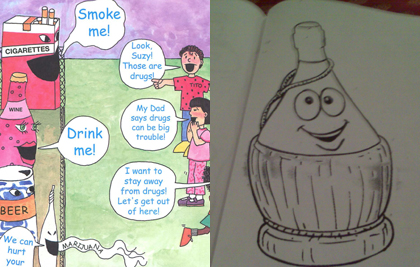
I recently posted about a pamphlet that our six-year-old son brought home from school equating wine and pot.
A friend living in the Veneto, Italy writes in with this comparison:
I thought I would share the work that our son brought home from his Montessori pre-school today: filastrocca del vino. A page of rhyming verse about making grapes into wine. Followed by pages to color about grapes + wine including a smiling Chianti bottle. Their fall learning unit was covering varietals through learning about grapes.
After the jump, find the text of the rhyming verse and a couple more pics (no joints). Read more…
Department of Greenwashing: Ceci La Luna lambrusco
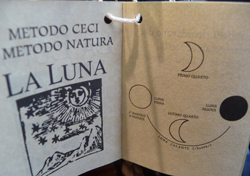 Are some in the wine trade exploiting consumers’ willingness for environmentally friendly products when the practices don’t measure up to more than a pile of manure? Consider an example.
Are some in the wine trade exploiting consumers’ willingness for environmentally friendly products when the practices don’t measure up to more than a pile of manure? Consider an example.
In late summer, The Moment blog at nytimes.com wrote a paean to lambrusco, the purple fizzy wine from Emilia-Romagna. The author had high praise for one in particular: “a rustic biodynamic beauty from Cantina Ceci, whose mild, deep fizz buoys its brooding purple embrace.” At least one New York City retailer also calls the $16 wine Biodynamic, a process of grape growing (and, to a lesser extent, winemaking) that goes beyond organic to synchronize some winemaking practices with the lunar cycle. Several other commentators have called it Biodynamic as well.
While the wine may be tasty, according to correspondence with Demeter Italy, the certifying authority in Italy, none of Cantine Ceci’s wine has ever been certified Biodynamic .
In the case of the Ceci lambrusco, it has the packaging of an artisanal product with twine around the neck and closure. Each bottle comes with a small booklet explaining the phases of the moon and how harvesting occurs while the moon is a mere crescent, as happens both when it waxes and wanes. The wine is called “La Luna,” meaning “the moon.” It does not appear on the producer’s web site.
In correspondence about La Luna, the wine’s importer to the US, Rosalie Sendelbach, said that the wine:
use to be Certified biodynamic until 2007, certification is based on testing each year and also costs quite a bit. its is also some what political. They are considered biodynamic and but did not certified this year. Minimum sulfite is used according to each vintage year and natural sulfite present in the wine during fermentation.
Demeter Italy said, in response to an email query, that no wine has been certified from Cantine Ceci. Three emails over a period of weeks to the winemaker Alessandro Ceci seeking comment about grape growing and winemaking practices at the cantine have gone without reply. Nor has the importer replied to a further request for comment about the response from Demeter Italy.
The wines from Cantine Ceci have received praise from Gambero Rosso Italian Wines and the Italian Sommeliers’ Duemila Vini: both list the Ceci estate and its many wines and consider it important, but there is no mention of organic or biodynamic production.
Jamie Wolff, a partner of Chambers Street Wines in Manhattan, a retailer that specializes in organic and natural wines, says “we do find more and more ‘green’ wines that make us raise our eyebrows.” He continued, “it’s important to get to know the people and visit so you get to know their intentions.” Chambers Street sells the “La Luna” lambrusco, which Wolff said was popular. They do not market the wine as Biodynamic.
Tom Maresca, a longtime observer of the Italian wine trade, had this to say when queried about the situation:
Italians by and large love Americans: they think we are warm and friendly. Unfortunately, some also believe that we are absolutely stupid about wine, and those people really think they can sell us anything. So this could well be a reputable company dealing with the American market as it believes it must be dealt with, and consequently seeing no harm in a little imaginative embroidery. Or it could be more consciously larcenous than that. Or, finally, it could be exactly what it says it is. I’m afraid I can’t really tell.
So what is a consumer to do? The shopper in a wine store can’t independently verify the provenance of every bottle she picks up. There needs to be some truth in marketing, but who can verify the claims? Independent agencies who extract fees? Government regulators? Wine shop owners? Critics? Bloggers?
Incidentally, I inquired with another Italian winery recently about their organic program in the vineyards. By return email within an hour, I had–without even asking–a copy of their certificate in my inbox. Three cheers for transparency. Read more…
WSJ: wine-rating system is badly flawed
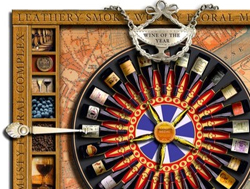 Saturday’s WSJ catches up with Robert Hodgson’s research on the randomness of gold medals in wine competitions. In case you missed our discussion here and many others on them there internets, you can check out the WSJ article for a recap. The story also applies the discussion to wine ratings and scores, underscoring their inherent subjectivity even though pallets of wine are bought and sold every day on these snapshots.
Saturday’s WSJ catches up with Robert Hodgson’s research on the randomness of gold medals in wine competitions. In case you missed our discussion here and many others on them there internets, you can check out the WSJ article for a recap. The story also applies the discussion to wine ratings and scores, underscoring their inherent subjectivity even though pallets of wine are bought and sold every day on these snapshots.
The author, Leonard Mladinow, wrote a book last year called “The Drunkard’s Walk: How Randomness Rules or Lives” (amazon; aff). In it, he has a brief section on inherent subjectivity and variation in wine descriptions and ratings. He points out the importance of aggregating several reviews and then expressing the standard deviation with the final score, as in “90 points, plus or minus 6.” Think that would fly in a sales email? Yeah, me either. But a site of user-generated reviews, such as cellartracker, could easily calculate a mean score and standard deviation from the reviews on any given wine in their database. It may not be ever-so-slightly more difficult to read than a single number but it would be a big score for accuracy in reflecting user experiences across diverse settings.
Anyway, check out the article. Here’s one quote for the candor file, from the publisher of a magazine that uses scores: “It is absurd for people to expect consistency in a taster’s ratings. We’re not robots.”
“A Hint of Hype, A Taste of Illusion” WSJ
(Image: a reduced size crop of an image credited to Chris Wadden that ran with the story)
Advertorial, 7-11, chocolate milk, freer trade – sipped and spit
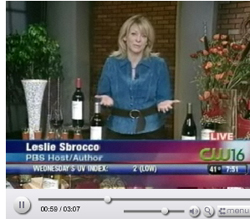 SIPPED: the hard question; SPIT: advertorial
SIPPED: the hard question; SPIT: advertorial
During what looked like an innocuous segment on Thanksgiving wines, Evan Dawson, a local TV news anchor, asks Leslie Sbrocco, wine book author and TV host, some tough questions. And they’re not about the turkey. Tune in to about 1:50 when he asks her about the Beringer wines she recommends: “Do you have a relationship with them that involves any sort of compensation?” Her reply: “Yes, this media tour is with the Beringer portfolio of wines.” The FTC would be proud of Dawson! [13WHAM]
SPIT: double standards
Speaking of the FTC, Blake Gray, former wine columnist for the SF Chronicle, has a lengthy post decrying the fact that the new FTC regulations come down harder on blogs than they do traditional media. [Gray Market Report]
SIPPED: funding freer trade
Frustrated by interstate shipping laws that thwart the ability to purchase wine out of state for 47 states? Consider bidding on wine lots in an auction to benefit the Specialty Wine Retailers Association, which fights legal battles for freer trade.
SIPPED: red wine
Chocolate milk, of all drinks, tries to muscle red wine out of the health news headlines: According to recent research as reported in the NYT, “flavanoid-rich cocoa” found in chocolate milk appears more effective at reducing inflammation that leads to atherosclerosis than regular milk! But the effects still aren’t as pronounced as with red wine. I can see it now: the choco-cabernet smoothie!
SIPPED: symbolic pricing
Joe Montana’s 500 acre estate that spans the Sonoma-Napa county line, is up for sale. The former 49ers QB, who also has a wine label, listed the property at $49 million. [WSJ]
SPIT: symbolic pricing
7-Eleven, the chain of 15,000 convenience stores, has announced their own wine label, Yosemite Road. Instead of pricing it at $7 and $11 a bottle for symbolic purposes, it will retail for $3.99. Aha! Maybe this will be the home of the choco-cabernet Slurpee? [AP]
SIPPED: another city winery
Hong Kong eclipsed New York City as the wine auction capital of the world this year, that we know. But this just in: Hong Kong has had a winery in the city limits since 2007. [CNN]
SIPPED: web voting
The website Foodbuzz recently distributed some blog awards and this blog won the category “blogger you would most want to be your personal sommelier.” Thank you for your votes but my question is, true to blogger stereotype, does that mean I have to pour wine in my pajamas? [Foodbuzz]
The declining dollar, through the wine glass
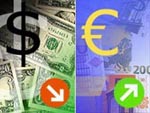 “The weak dollar makes American products cheaper overseas, buoying sales, and makes imports more expensive, encouraging consumers at home to buy American…As the dollar fell, gold reached $1,117.40 an ounce at the stock market’s close on Wednesday, setting another record high as hedge fund managers and wealthy speculators continued to buy the precious metal.” – NYT 11/11/09
“The weak dollar makes American products cheaper overseas, buoying sales, and makes imports more expensive, encouraging consumers at home to buy American…As the dollar fell, gold reached $1,117.40 an ounce at the stock market’s close on Wednesday, setting another record high as hedge fund managers and wealthy speculators continued to buy the precious metal.” – NYT 11/11/09
Applying this to wine:
1. About two-thirds of wine sold in America is produced in America, by volume. If you’re in the portion that drinks imported wine, what price would it take for you to consider switching to domestic wine? If foreign exchange rates fell to $2 to the euro (a decline of 33% from current levels) would that be enough to make you drink more domestic wines? Or, say, $3 to the euro, double the current rate? [shudder] Bear in mind too that FX moves are often parabolic since wholesalers and retailers seek to maintain the same markup even when the base cost rises. [Update: please see comment below from Matt S.]
2. Will domestic wineries start targeting overseas markets more? Apparently they already have since the Wine Institute reports that exports of US wine have doubled since 2002, when the dollar was at a high. But will American wines exported be more than Blossom Hill and white zinfandel?
3. With the rising price of gold, maybe that gold-encrusted Jerobaum of Champers wasn’t such a bad deal after all?!?
Related: “Why so few tasty American wines under $12? Wine importer Bobby Kacher“
Butternut squash ravioli with sage butter: wine pairing
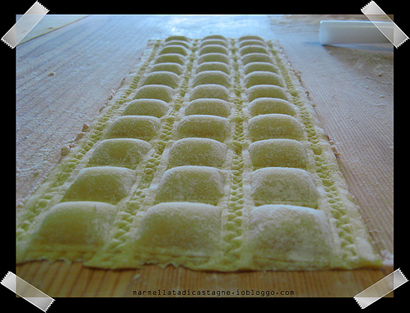
Tis the season for squash and gourds. But more than looking at them as decoration, I prefer eating them. And for butternut squash, few ways are better than as ravioli with sage/butter sauce.
So, which wine would you pair with these delicious, autumnal ravioli? I have some thoughts but will hold them for the comments.
To anticipate your comments, I didn’t call it “impossible” as is my wont, because it’s merely a tricky blend of sweet, salt, fat and herbs.
If you want an impossible pairing for this week, surf over to the WSJ and read Jonathan Safran Foer on eating dog. But apparently eating a low-fat diet will make you less pissy than eating a low carb diet, so maybe staying here and thinking about pasta will put you in a better mood.
Taste seven great holiday wines with Dr. Vino!
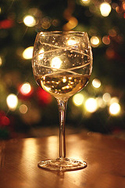 The holiday wine tasting is back! Join me on 12/10 to taste through seven great wines for gifting and drinking!
The holiday wine tasting is back! Join me on 12/10 to taste through seven great wines for gifting and drinking!
I’ll be pouring seven great wines-–red, white and bubbly (including one tasty kosher wine!). We’ll talk party strategies, how to impress the boss with a gift wine, and good food pairings. NO prior wine education is necessary, just a willingness to try something new!
The session will be held at the White Wood House, a historic property on E. 29th St in New York City where the first floor is a space dedicated to wine education. Copies of my books will be available for purchase and I’d be happy to sign them–also good gifts!
So I hope to see you there on Thursday 12/10!
6:30 – 8:00 PM. Registration and details
(image)



